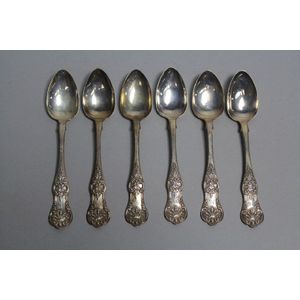Victorian Fish & Dessert Service for 12
You must be a subscriber, and be logged in to view price and dealer details.
Subscribe Now to view actual auction price for this item
When you subscribe, you have the option of setting the currency in which to display prices to $Au, $US, $NZ or Stg.
- Caryatid - A Greek term that in architecture applies to a carved or cast female figures that acts as a column or pillar, supporting an entablature on her head.
In decorative arts , in furniture of the Renaissance and Classical Revival periods. Male figures are known as Atlantes.
Carved figures are rare on Australian furniture until the later 19th century, Australian craftsmen generally preferring to adopt the designs of the pattern books to rather more simple forms, such as scrolls or columns. - Sterling Silver - Sterling silver is a mixture of 92.5% pure silver and 7.5% of another metal, usually copper. Fine silver is 99.9% pure silver, and is relatively soft and the addition of the very small amount of copper gives the metal enough strength and hardness to be worked into jewellery, decorative and household objects.
- Finial - An architectural decoration, found on the upper parts of of an object. On furniture they are usually found on pediments, canopies and shelf supports. On smaller ceramic or silver items, such as spoons, they may decorate the top of the item itself, or the lid or cover where they provide a useful handle for removal.
Finials have a variety of shapes and forms. They may be urn-shaped, baluster shaped round or spiral, but usually taper into an upper point. Many real life shapes may also be used as finials, such as pineapples, berries, pinecones, buds, lotus and acorns. Sometimes animals such as a lion are depicted, or fish and dolphins. - Victorian Period - The Victorian period of furniture and decorative arts design covers the reign of Queen Victoria from 1837 to 1901. There was not one dominant style of furniture in the Victorian period. Designers used and modified many historical styles such as Gothic, Tudor, Elizabethan, English Rococo, Neoclassical and others, although use of some styles, such as English Rococo and Gothic tended to dominate the furniture manufacture of the period.
The Victorian period was preceded by the Regency and William IV periods, and followed by the Edwardian period, named for Edward VII (1841 ? 1910) who was King of the United Kingdom and the British Dominions and Emperor of India for the brief period from 1901 until his death in 1910. - Hallmarks - A mark stamped on articles of precious metals in Britain, since the 14th century, certifying their purity. It derives its name from the Guild Hall of the Goldsmiths' Company, who recieved its Charter in 1327 giving it the power to assay (test the purity) and mark articles of gold and silver.
The hallmark will consist of several marks, including the:
- silver standard mark, indicating the purity of the metal. Sterling silver is .925 pure silver.
- the city mark indicating the city in which it was assayed eg London, Birmingham, York etc.
- the date mark, usually a letter of the alphabet in a particular font and case,
- a duty mark, indicating whether duty had been paid to the crown, and only in use from 1784 to 1890
The piece may include an additional mark, the maker's mark, although not forming part of the hallmark, will be located in the vicinity of the hallmarks.
Sometimes silver plated items will bear faux hallmarks, often confusing those not familiar with silver markings.
This item has been included into following indexes:
Visually similar items

Four small mixed French silver table accessories. Variously marked, comprising a cast gilt washed spoon, a sifting spoon with a foliate handle, a hollow handled fork with a knot motif, and a pierced shovel with a hollow handle and a delicate neoclassical d

Set of 11 Russian Imperial silver soup spoons, Moscow 1851 (assay master Andrey Antonovich Kovalsky), 22 cm long, 735 grams approx Provenance: Owners fled Russian circa 1917 and settled in Tientsin (Tianjin) China and became part owners of Talati House Hot

Six sterling silver coffee spoons with golf club handles, marked Stg

Victorian period set of five Queens Pattern tea spoons. In sterling silver marked Glasgow, GoN, 1857 13 cm long, 100g
